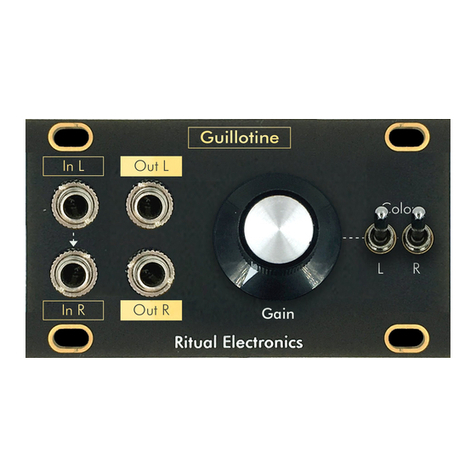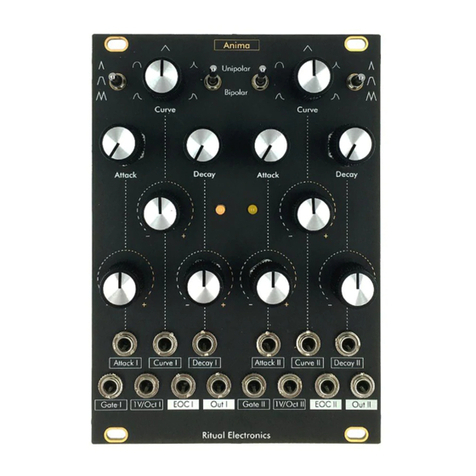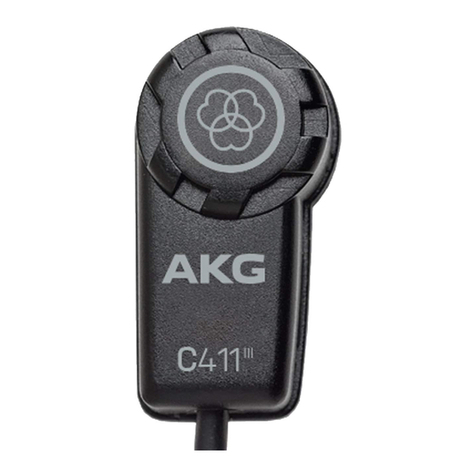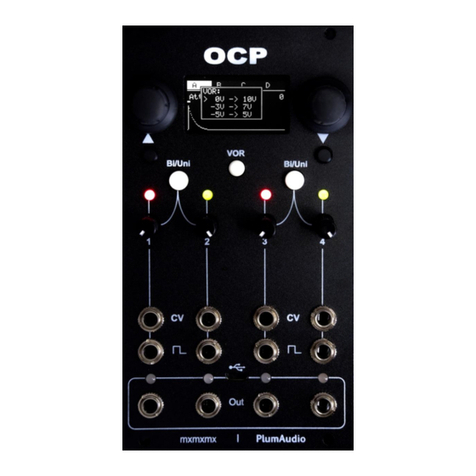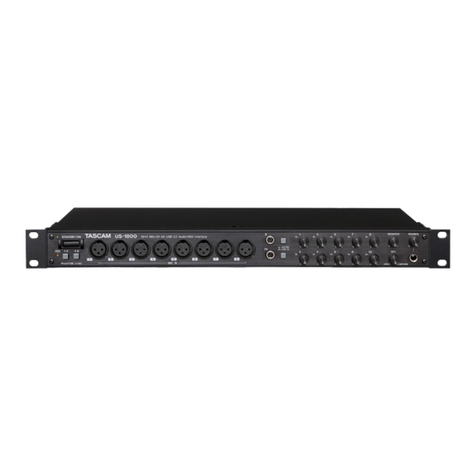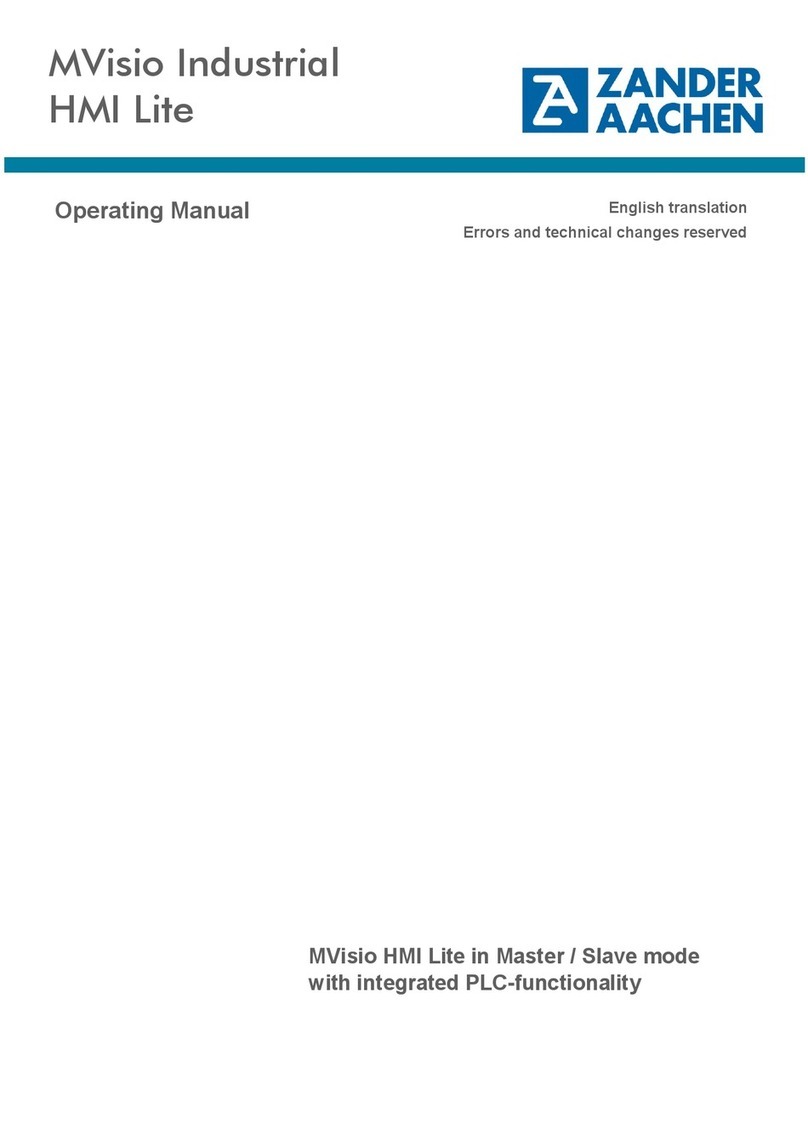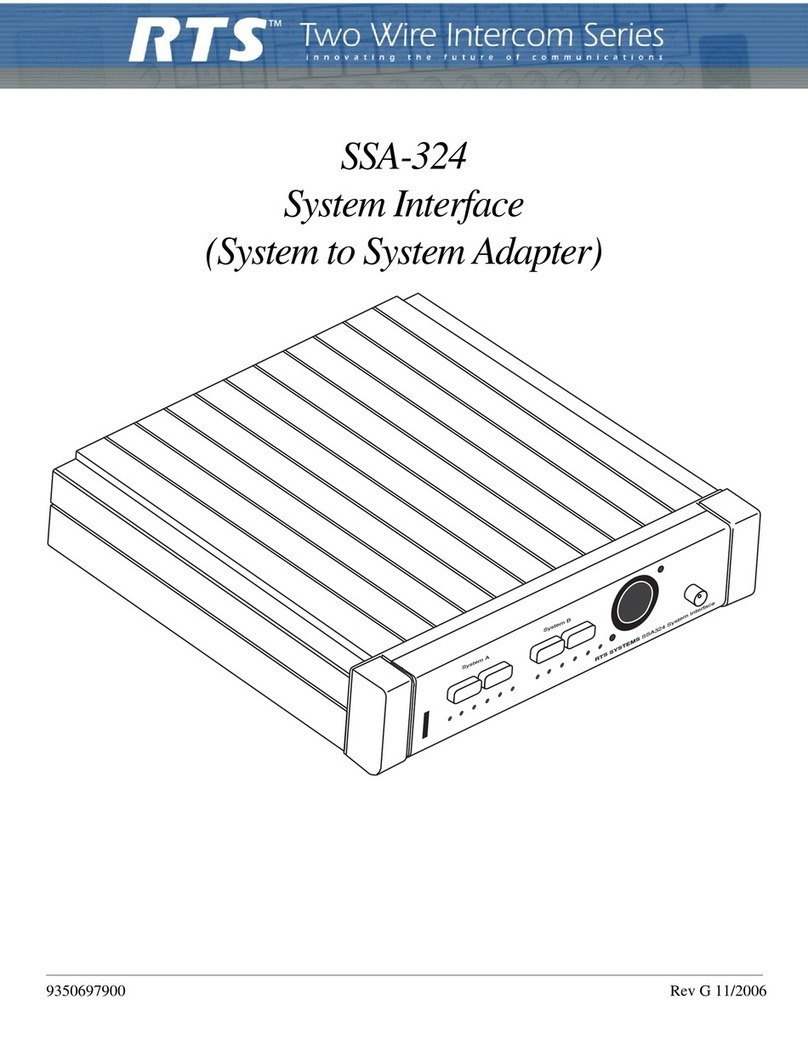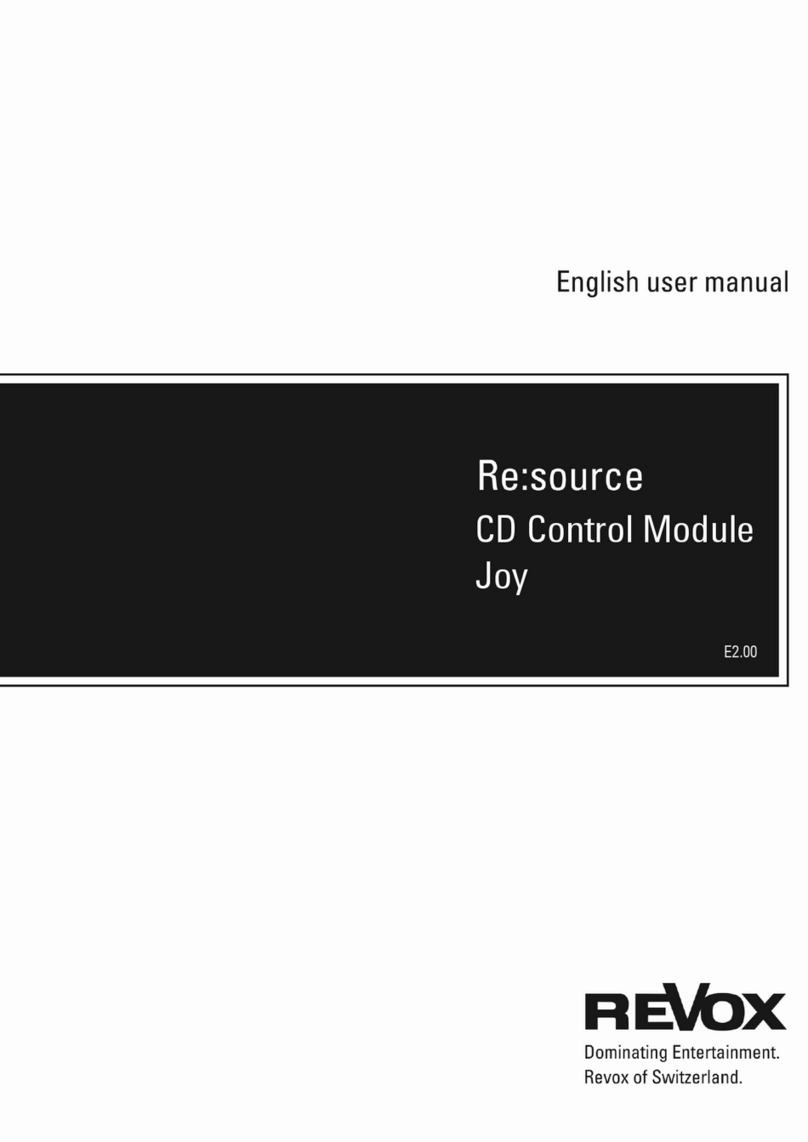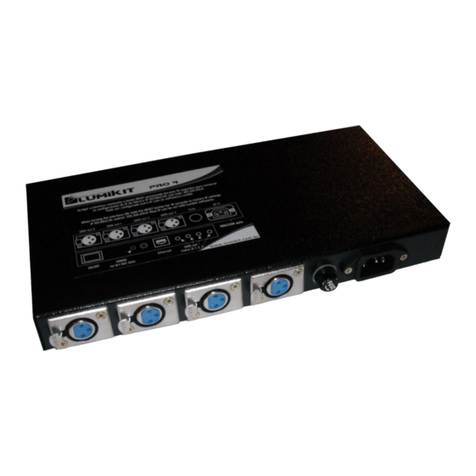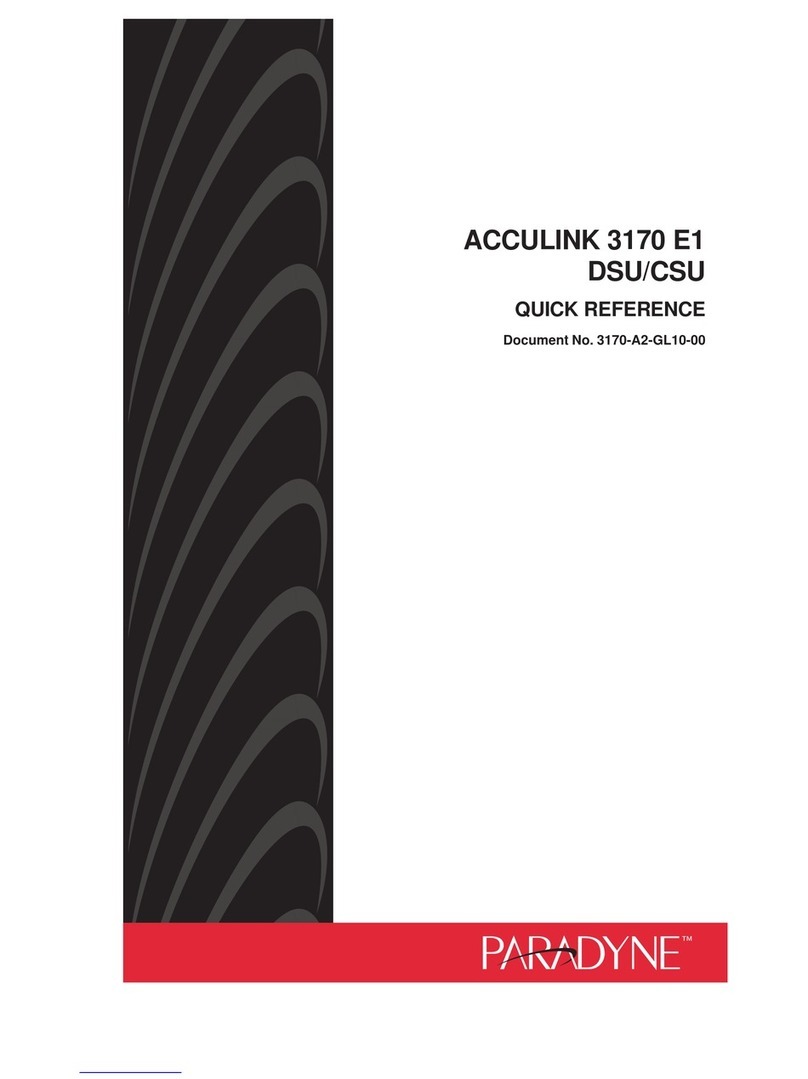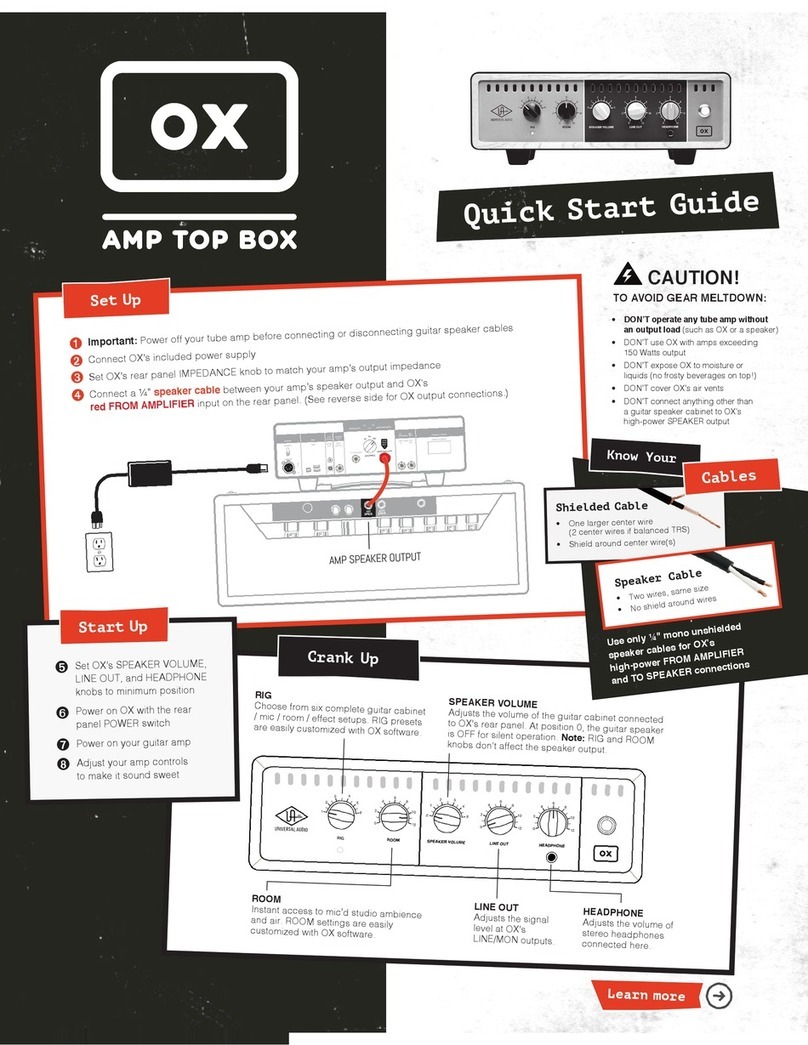Ritual Electronics Crime User manual

Ritual Electronics
Crime
Crime
High Pass
Diodes
II
III
IV
V
VI
I
II
III
IV
V
VI
I
Low Pass
II
III
IV
V
VI
I

2
Summary
03................Warranty
04................Installation
05................Connection
06................Overview
07.................Controls
08.................Diodes
09.................Low Pass
10.................High Pass
11.................Crime Out
12.................Switching Technology
13.................Patches

3
Crime
Thank you for purchasing Ritual Electronics Crime.
Your module has been assembled with care in our
studio in Marseille, France.
You can find your module on Modulargrid:
https://www.modulargrid.net/e/ritual-electronics-crime-
For any remarks and informations, contact us at:
For video demos and patch ideas check:
https://www.youtube.com/ritualelectronics
https://www.instagram.com/ritualelectronics
Limited warranty
Ritual Electronics warrants this product to be free of defects in
materials or construction for a period of one year from the date
of purchase.
Malfunction resulting from wrong power supply voltages, backwards
or reversed eurorack bus board cable connection, abuse of the
product or any other causes determined by Ritual Electronics to be
the fault of the user are not covered by this warranty, and normal
service rates will apply.
During the warranty period, any defective products will be repaired
or replaced, at the option of Ritual Electronics, on a return-to-Ritual
Electronics basis with the customer paying the transit cost to Ritual
Electronics. The return of your module is on us.
Ritual Electronics implies and accepts no responsibility for harm to
person or apparatus caused through operation of this product.

4
Installation
Always turn your eurorack case off before installing
a module.
Do not touch any electrical terminals when attaching any
Eurorack bus board cable.
Crime does not have a shrouded header. Please connect it
with care. Align the power cable’s red stripe with the “Red”
text on the module.
Ritual Electronics Crime does require 9mA on +12V, 7mA
on -12V and 0mA on 5V.
You will need 4HP of free space in your Eurorack case to
install Crime. The module is 25mm deep.
Crime is an expander for Miasma.
Crime can not be used without connecting it to Miasma with
the included 4 pin cable.

5
Connection
I. Remove any diodes present in Miasma’s female
header on the back of the module (fig. I)
II. Connect the male end of the included cable to
the Miasma’s female header, black stripe must face
down (fig. II)
III. Connect the other end of the cable to Crime’s
male header, same colour facing down (fig. II)
fig. I
fig. II

6
Overview
Crime lets you chose from 6 different diodes for
your Miasma, 6 different Low Pass frequencies and 6
different High Pass frequencies.
There are 5 diodes combinations you can chose from using
the top rotary switch. Some give symmetrical distortions and
some are asymmetrical.
Crime also has a female header on position VI for you to put
your diodes of choice. You can also have this position witout
diodes for extra harshness!
The Low Pass Filter in the distortion core can help tame
high frequencies, specially when Miasma’s feedback start to
squeal.
The High Pass Filter is slightly resonant and works wonders
whether it is to clean the low end or to create ear piercing
noises.
Crime connects to Miasma with an included cable. It replaces
the diodes in Miasma’s female diode header. This way you
won’t have to take Miasma out of your case to change
diodes and explore new distortion flavours.
Note each diode has a different voltage drop, resulting
in different loudness. You can still compensate for volume
changes using Miasma’s level trimmer.

7
Crime controls
Crime Out
Bypasses the additional gain
stages and blend circuitry of
Miasma
High Pass Rotary Switch
Chose between 6 different high
pass cutoff frequencies. Position I is
fully open
Low Pass Rotary Switch
Chose between 6 different low
pass cutoff frequencies. Position I is
fully open
Diodes Rotary Switch
Chose between 5 different diodes
combinations. Position VI is the
module’s female header - custom
diodes
Crime
High Pass
Diodes
II
III
IV
V
VI
I
II
III
IV
V
VI
I
Low Pass
II
III
IV
V
VI
I

8
Diodes
You probably already messed with the included baggy of diodes
sent with Miasma. With Crime you now have 6 different diode
configurations on hand. They all have a different character. They are
arranged from the “softest” to the hardest. The first 5 positions are as
follow:
- - Position I is 3x 1N4148 diodes (the stock Miasma diodes) in an asymetrical
configuration
- - Position II is 2x 1N4148 in a symetrical configuration
- - Position III is 3x BAS20 diodes in an asymetrical configuration
- - Position IV is 1x 1SS390 in an asymetrical configuration
- - Position V is 3x Blue LEDs in an asymetrical configuration
The sixth position is left for you to pick. We have installed a female
header for you to slide in any diodes you want, as with Miasma’s
female header.
You can still use the original diode baggy and your beloved germanium diodes
or coloured LEDs.
You can also leave the header empty for an extra hard position.

9
Low Pass
The Low Pass filter switches capacitors in the distortion’s gain cell.
It results in a one pole filter. Exactly where the diodes are. Different
capacitor values give different corner frequencies.
This filter is very useful when Miasma’s feedback starts squealing or
to roll off the highs as the tone knob on a distortion pedal would.
- - Position I is neutral, no capacitor, no filtering.
- - Position II filters at 3.6 kHz
- - Position III filters at 2.7 kHz
- - Position IV filters at 1.4 kHz
- - Position V filters at 1 kHz
- - Position VI filters at 660 Hz

10
High Pass
The High Pass filter switches resistors in a special resonant high pass
circuit*.
It works wonder to clean up the low frequencies or to generate ear
piercing sounds.
The amount of resonance is frequency dependent. It means the further
you go in the positions, the more resonance you have. Depending on
your input signal and feedback setting the filter can self oscillate.
- - Position I is neutral, no filtering.
- - Position II filters at 75 Hz
- - Position III filters at 175 Hz
- - Position IV filters at 375 Hz
- - Position V filters at 555 Hz
- - Position VI filters at 666 Hz
* Due to Miasma’s circuits I had to look for a long time to find a way to implement a HPF for Crime. For
the nerds out there you can check TI’s 2008 paper “A new filter topology for analog high-pass filters”
on which the filter is based.

11
Crime Out
Crime connects to Miasma’s first gain stage, where
the diodes are. The signal is then passed on several
other gain stages to give it character and to round it
off. Finally it goes in the Blend circuitry.
If you don’t want any of these refinements, use Crime
Out.
Crime Out bypasses all the bells & whistles to focus
on a raw, violent and squarish signal.
Special bonus: it is a bit louder - depending on the
diodes selected and your input signal this output may
go up to 20Vpp!

12
Switching Technology
Crime’s first version (2018-2020, RIP) was very primitive. Its first
purpose was to change diodes without taking Miasma out of your
rack.
Of course it soon started to be used as a performance tool. With
one drawback. When changing diode, the rotary switch would
disconnect for a fraction of a second resulting in a loud beep. I was
not pleased with this. When done on loud sound systems it was a bit
annoying... and potentially ear damaging.
Many solutions were tried in the 2+ years of development. We finally
settled for a super fast electronic switch, controled by the original
rotary switch. This way the pleasant feeling of switching remained
while the electronic switch IC made sure to switch in literally no time,
avoiding the beeeeeeeeeeep.
Overkill some would say (it is a lot of circuitry for such a small
module) but the interaction and precision are great. Worth it, trust
me.

13
Patches
Patch #1 - Self Patching
The Crime Out can be used in the Feedback In of Miasma, or
as an audio rate modulation signal for the Gain or Feedback
CV inputs.
Patch notes
Crime, Crime Out ------------ Miasma, CV ins
Crime, Crime Out ------------ Miasma, Fdbk In
Feedback
Gain
Level
Miasma
Blend
_+_+
Fdbk CV
Fdbk Out
Fdbk OutOutOut
InGain CV
Fdbk In
Crime
High Pass
Diodes
II
III
IV
V
VI
I
II
III
IV
V
VI
I
Low Pass
II
III
IV
V
VI
I

14
Patches
Patch #2 - Disortion ping
Since the High Pass filter in Crime is resonant, it can be
pinged to create percussions. Try different cutoff frequencies,
adding Low Pass filtering and feedback!
Patch notes
Anima, Trigger Out ------------ Miasma, In
Anima
Attack
Curve
Decay
_+
_+_+
_+_+_+
Attack
Curve
Decay
_+
Unipolar
Bipolar
Attack I Curve I
Out I
Out I
EOC I
EOC I
Decay I
Gate I 1V/Oct I
Attack II Curve II
Out II
Out II
EOC II
EOC II
Decay II
Gate II 1V/Oct II
Feedback
Gain
Level
Miasma
Blend
_+_+
Fdbk CV
Fdbk Out
Fdbk Out
Out
Out
InGain CV
Fdbk In
Crime
High Pass
Diodes
II
III
IV
V
VI
I
II
III
IV
V
VI
I
Low Pass
II
III
IV
V
VI
I
Other manuals for Crime
1
Table of contents
Other Ritual Electronics Recording Equipment manuals
Popular Recording Equipment manuals by other brands
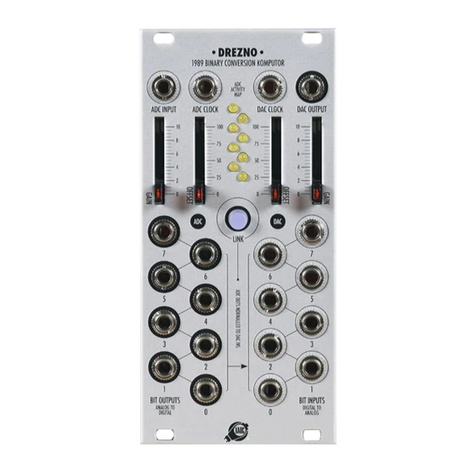
Xaoc Devices
Xaoc Devices DREZNO Operator's manual
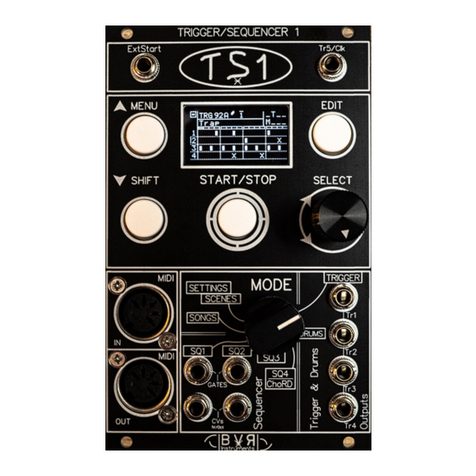
BVR Instruments
BVR Instruments TS1 reference guide

Brigade
Brigade MDR-504GW-500 Installation and operation guide

Thinka
Thinka KNX HKV1.2 quick start guide
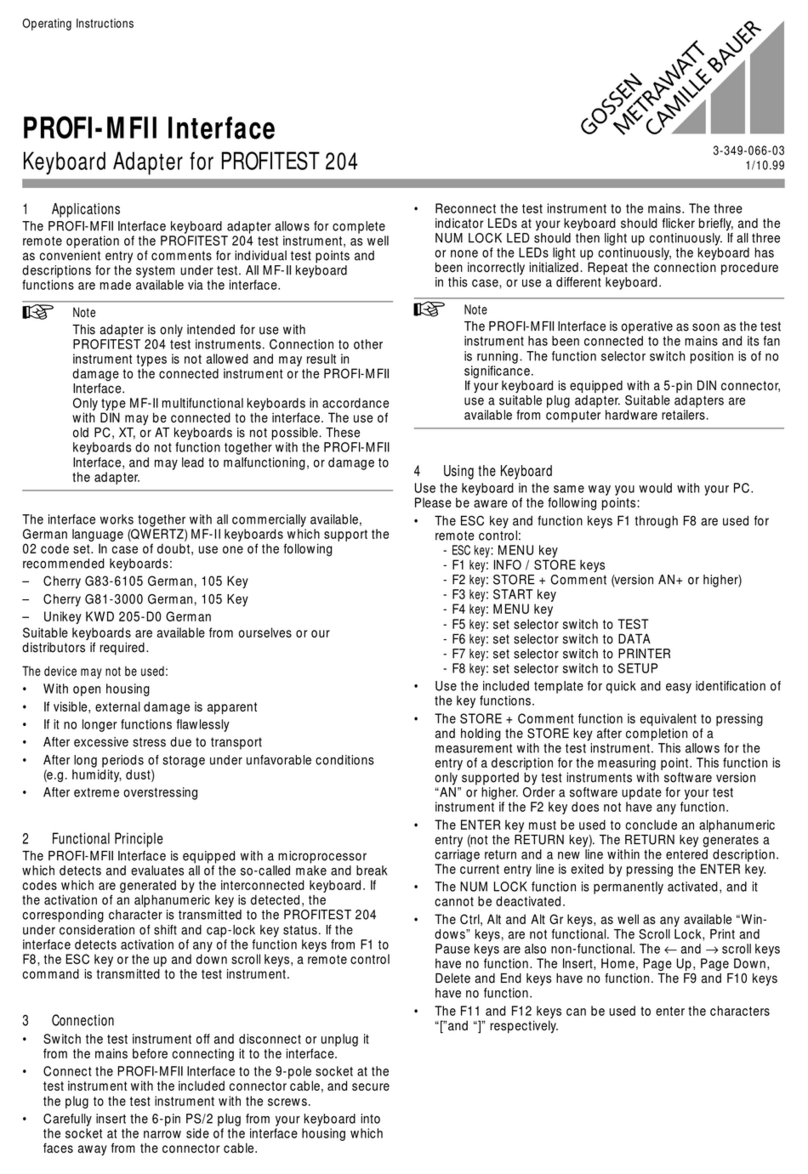
Gossen MetraWatt
Gossen MetraWatt PROFI-MFII operating instructions
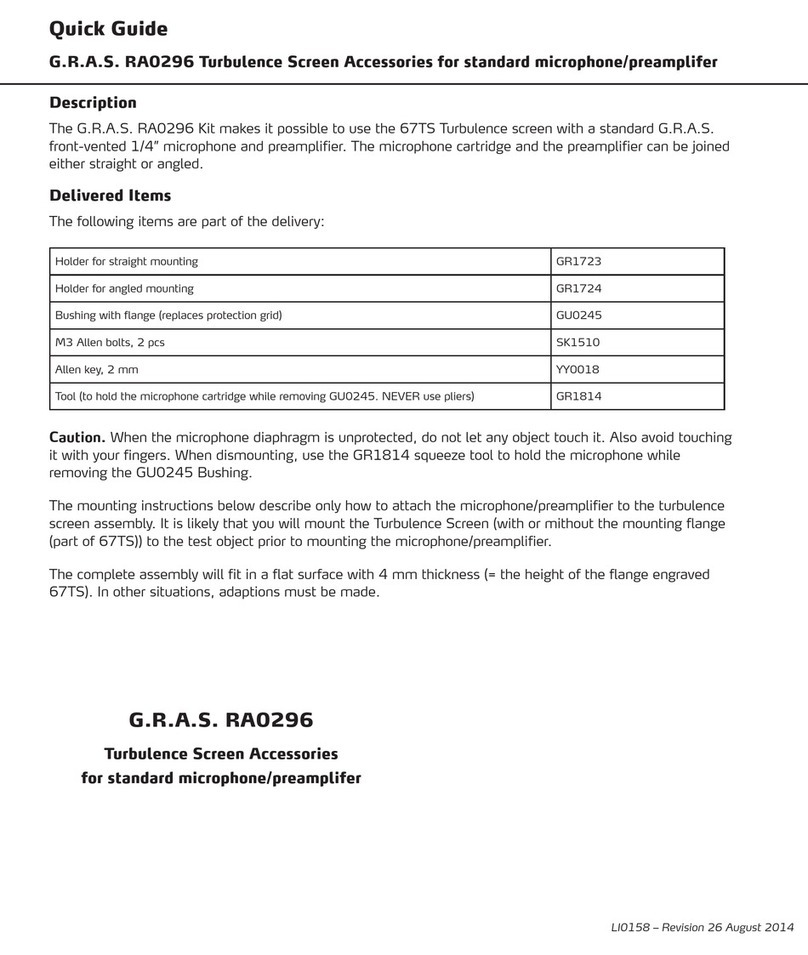
G.R.A.S.
G.R.A.S. RA0296 quick guide
